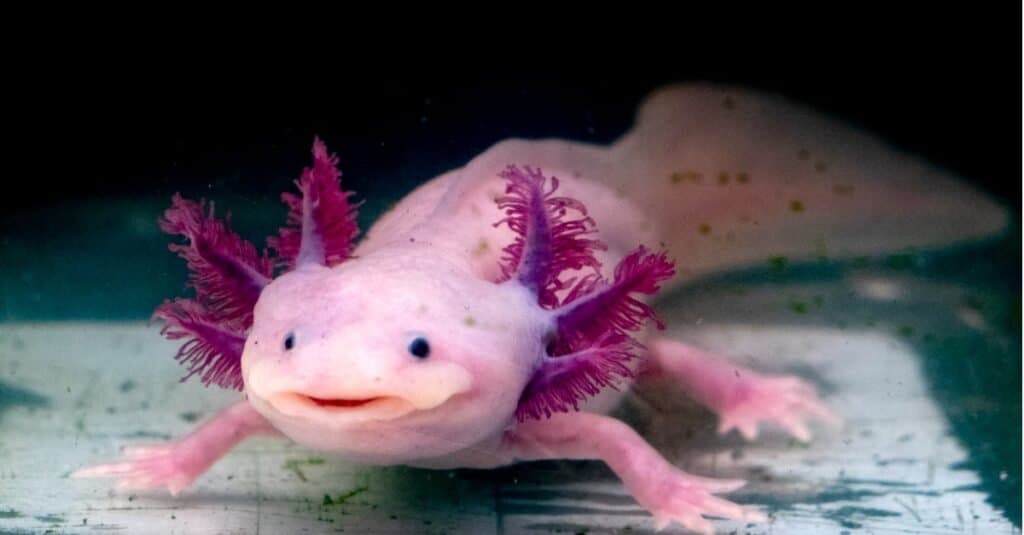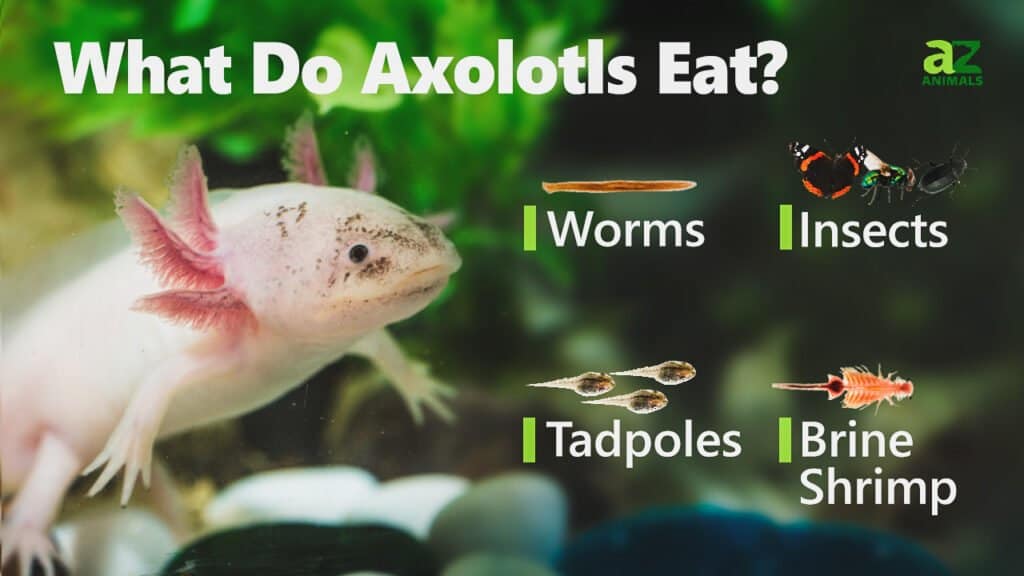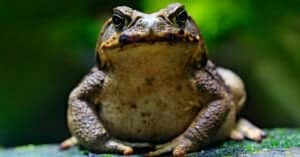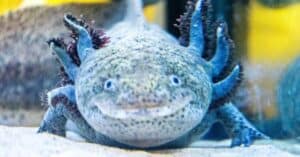Axolotl as a Pet: The Ultimate Guide to Caring For Your Axolotl
@media (min-width: 481px) {
.mobile-top-content {
display: none;
}
}
#mobileTopContentCTACarouselControls { overflow: hidden; text-overflow: ellipsis; white-space: nowrap; }
.mobile-top-content .more { color: #fff; }
.mobile-top-content a { color: #fff; text-decoration: underline; }
.mobile-top-content a:hover { color: #fff; text-decoration: underline; }
@media (max-width: 480px) {
.mobile-top-content {
background-color: #06a10b;
color: #fff;
text-align: center;
/*height: 60px;
padding-top:5px;*/
font-size:80%;
/* display: block; */
margin: 0px -30px;
}
}
Axolotls are incredibly unique amphibians native to just one small area in Mexico City. Thankfully, their populations have increased through conservation and their popularity in the pet trade! In recent years, axolotls have become well-loved pets amongst herpetology hobbyists. But how do you care for these bizarre animals, and do they make good pets for beginners and experts alike?
Let’s explore how to keep axolotls in captivity below, from the costs of their care to everything you’ll need for them, like their enclosure, water filters, substrate, and more. We’ll also touch on what pet axolotls should eat to stay healthy and happy.
Do Axolotls Make Good Pets?

iStock.com/izanbar
Axolotls can make great pets, but they aren’t ideal for beginner pet owners who have no experience with keeping amphibians. They can’t be handled or removed from the water, and they must be housed in 20+ gallon tanks with treated, filtered water to survive. Though they can tolerate slight shifts in temperature and water quality from time to time, they have extremely sensitive skin.
Of course, this isn’t to say that beginners can’t necessarily keep axolotls as pets. Just be advised that they are far from the easiest amphibians to keep in captivity! Aside from having sensitive skin, their bodies are made of soft cartilage rather than bone. This makes them quite fragile to injuries and illnesses.
Another important thing to note is it can be difficult to find exotic pet veterinarians willing to treat axolotls. Due to axolotls’ rarity as pets and their unusual biological qualities, many vets simply don’t have enough knowledge or experience with them to dedicate time to treating them professionally.
And although axolotls, like many amphibians, have regenerative qualities, they are still quite vulnerable to various infections and illnesses often caused by improper care. Their water must be kept at a certain temperature and filtered constantly. You should also be comfortable with handling brine shrimp and worms, as they will ideally make up the bulk of your axolotl’s diet.
Finally, be sure to check the legality of axolotls as pets in your state or country. California, Maine, New Jersey, and Virginia all notably prohibit the ownership of them. Additionally, they are legal in New Mexico, but it is illegal to import them from other states. Some locations also require permits to own axolotls. And make sure you adopt your axolotl from a reputable amphibian/reptile/exotic pet breeder rather than a pet shop! In general, breeders tend to be more knowledgeable and engage in more ethical practices than chain pet stores.
How Much Do Pet Axolotls Cost?

Meggyn Pomerleau/Shutterstock.com
The cost of a single pet axolotl ranges from around $20 to $70. This largely depends on the color and morph or variation you purchase, as some are far rarer and more difficult to breed than others. Certain rare or unusual variants like leucistic, lavender, or piebald axolotls can cost over $100.
Keep in mind this is only one part of the total cost of your axolotl’s care. Other likely costs include an enclosure, a water filter, substrate, vet visits, and food.
In general, thanks to their recent popularity in the pet trade, axolotls are fairly inexpensive to purchase. They are commonly sold by amphibian and reptile breeders for low prices, usually less than $100 each, unless the axolotl is a particularly rare variant.
However, the axolotl itself is only a small part of the total cost of caring for and housing one of these animals. They can live for over 10 years in captivity, making them fairly long-term exotic pets. Their initial enclosure setup usually costs somewhere between $200 and $400 for a tank, water filter, substrate, and potentially tank decorations.
It is also important to keep in mind the recurring costs of caring for an axolotl. This includes food, substrate, vet check-ups, and potential treatments for illnesses or injuries. You may need to replace your water filter over time. You’ll also need to repair or replace or enclosure if it leaks or you accidentally damage it. It’s a good idea to keep a “pet fund” for your axolotl on hand to deal with any emergencies as they come.
What Do Pet Axolotls Need?

Spok83/Shutterstock.com
You’ll need to keep your axolotl in an aquarium enclosure with slightly cooler than room temperature water, a water filter, substrate, and very minimal tank decor. They do best in 20+ gallon enclosures and should live alone, as they can be territorial.
Compared to most other common pet amphibians, the enclosure setup for an axolotl is fairly minimal. Aside from substrate and a hiding spot or two, they don’t need much furnishings. In fact, their skin is so sensitive that their enclosures shouldn’t contain any objects with sharp or textured surfaces.
The most important part of your pet axolotl’s tank is the temperature and condition of the water. Axolotls are fairly cool-water animals, faring best in water with a range of 60F to 65F. Additionally, you’ll need to treat the water in their enclosure with a water conditioner. This will remove harmful substances like chlorine and make it safe for their sensitive gills and skin. The water’s pH level should be between 6.5 and 7.5 at all times.
Your axolotl’s tank will also benefit from a slow-moving water filter. Changing the water completely can stress them out, so partial water changes weekly are preferable. Be sure to spot clean the tank daily for waste and uneaten food.
The bottom of your axolotl’s tank should have a thin layer of substrate, ideally very fine, aquarium-safe sand or large, smooth river rocks. Your axolotl may accidentally consume substrates like gravel and pebbles.
If you opt for tank decor, be very careful and selective about it! Again, anything with sharp edges or rough surfaces can be dangerous, and you should also avoid anything small enough for your axolotl to accidentally swallow.
What Do Axolotls Eat?

A-Z-Animals.com
Axolotls are carnivores. In captivity, they should primarily eat brine shrimp, water fleas, worms such as nightcrawlers and blackworms, and a small amount of raw beef and liver. Commerical pellet food is also available from pet shops and online retailers.
When it comes to your pet axolotl’s feeding schedule, offer them as much as they’ll eat in a 5-to-10-minute period two to three times a week. Babies and juveniles can eat slightly more often, or roughly every other day. Axolotls need a few “off days” from eating to digest their food, so daily feedings aren’t necessary.
The best way to feed an axolotl is to simply drop small pieces of food directly into their tank. Keep any food items smaller than the width of the space between the axolotl’s eyes to prevent choking or digestive issues. To avoid directly handling their food, use tweezers or forceps. You can get your axolotl’s attention by lightly tapping the side of the tank or gently waving the food near their face to let them know it’s time to eat.
More from A-Z Animals
.more-snake-card-image { max-height:140px !important; }
@media (min-width: 481px) {
.mobile-top-content {
display: none;
}
}
#mobileTopContentCTACarouselControls { overflow: hidden; text-overflow: ellipsis; white-space: nowrap; }
.mobile-top-content .more { color: #fff; }
.mobile-top-content a { color: #fff; text-decoration: underline; }
.mobile-top-content a:hover { color: #fff; text-decoration: underline; }
@media (max-width: 480px) {
.mobile-top-content {
background-color: #06a10b;
color: #fff;
text-align: center;
/*height: 60px;
padding-top:5px;*/
font-size:80%;
/* display: block; */
margin: 0px -30px;
}
}
Axolotls are incredibly unique amphibians native to just one small area in Mexico City. Thankfully, their populations have increased through conservation and their popularity in the pet trade! In recent years, axolotls have become well-loved pets amongst herpetology hobbyists. But how do you care for these bizarre animals, and do they make good pets for beginners and experts alike?
Let’s explore how to keep axolotls in captivity below, from the costs of their care to everything you’ll need for them, like their enclosure, water filters, substrate, and more. We’ll also touch on what pet axolotls should eat to stay healthy and happy.
Do Axolotls Make Good Pets?

iStock.com/izanbar
Axolotls can make great pets, but they aren’t ideal for beginner pet owners who have no experience with keeping amphibians. They can’t be handled or removed from the water, and they must be housed in 20+ gallon tanks with treated, filtered water to survive. Though they can tolerate slight shifts in temperature and water quality from time to time, they have extremely sensitive skin.
Of course, this isn’t to say that beginners can’t necessarily keep axolotls as pets. Just be advised that they are far from the easiest amphibians to keep in captivity! Aside from having sensitive skin, their bodies are made of soft cartilage rather than bone. This makes them quite fragile to injuries and illnesses.
Another important thing to note is it can be difficult to find exotic pet veterinarians willing to treat axolotls. Due to axolotls’ rarity as pets and their unusual biological qualities, many vets simply don’t have enough knowledge or experience with them to dedicate time to treating them professionally.
And although axolotls, like many amphibians, have regenerative qualities, they are still quite vulnerable to various infections and illnesses often caused by improper care. Their water must be kept at a certain temperature and filtered constantly. You should also be comfortable with handling brine shrimp and worms, as they will ideally make up the bulk of your axolotl’s diet.
Finally, be sure to check the legality of axolotls as pets in your state or country. California, Maine, New Jersey, and Virginia all notably prohibit the ownership of them. Additionally, they are legal in New Mexico, but it is illegal to import them from other states. Some locations also require permits to own axolotls. And make sure you adopt your axolotl from a reputable amphibian/reptile/exotic pet breeder rather than a pet shop! In general, breeders tend to be more knowledgeable and engage in more ethical practices than chain pet stores.
How Much Do Pet Axolotls Cost?

Meggyn Pomerleau/Shutterstock.com
The cost of a single pet axolotl ranges from around $20 to $70. This largely depends on the color and morph or variation you purchase, as some are far rarer and more difficult to breed than others. Certain rare or unusual variants like leucistic, lavender, or piebald axolotls can cost over $100.
Keep in mind this is only one part of the total cost of your axolotl’s care. Other likely costs include an enclosure, a water filter, substrate, vet visits, and food.
In general, thanks to their recent popularity in the pet trade, axolotls are fairly inexpensive to purchase. They are commonly sold by amphibian and reptile breeders for low prices, usually less than $100 each, unless the axolotl is a particularly rare variant.
However, the axolotl itself is only a small part of the total cost of caring for and housing one of these animals. They can live for over 10 years in captivity, making them fairly long-term exotic pets. Their initial enclosure setup usually costs somewhere between $200 and $400 for a tank, water filter, substrate, and potentially tank decorations.
It is also important to keep in mind the recurring costs of caring for an axolotl. This includes food, substrate, vet check-ups, and potential treatments for illnesses or injuries. You may need to replace your water filter over time. You’ll also need to repair or replace or enclosure if it leaks or you accidentally damage it. It’s a good idea to keep a “pet fund” for your axolotl on hand to deal with any emergencies as they come.
What Do Pet Axolotls Need?

Spok83/Shutterstock.com
You’ll need to keep your axolotl in an aquarium enclosure with slightly cooler than room temperature water, a water filter, substrate, and very minimal tank decor. They do best in 20+ gallon enclosures and should live alone, as they can be territorial.
Compared to most other common pet amphibians, the enclosure setup for an axolotl is fairly minimal. Aside from substrate and a hiding spot or two, they don’t need much furnishings. In fact, their skin is so sensitive that their enclosures shouldn’t contain any objects with sharp or textured surfaces.
The most important part of your pet axolotl’s tank is the temperature and condition of the water. Axolotls are fairly cool-water animals, faring best in water with a range of 60F to 65F. Additionally, you’ll need to treat the water in their enclosure with a water conditioner. This will remove harmful substances like chlorine and make it safe for their sensitive gills and skin. The water’s pH level should be between 6.5 and 7.5 at all times.
Your axolotl’s tank will also benefit from a slow-moving water filter. Changing the water completely can stress them out, so partial water changes weekly are preferable. Be sure to spot clean the tank daily for waste and uneaten food.
The bottom of your axolotl’s tank should have a thin layer of substrate, ideally very fine, aquarium-safe sand or large, smooth river rocks. Your axolotl may accidentally consume substrates like gravel and pebbles.
If you opt for tank decor, be very careful and selective about it! Again, anything with sharp edges or rough surfaces can be dangerous, and you should also avoid anything small enough for your axolotl to accidentally swallow.
What Do Axolotls Eat?

A-Z-Animals.com
Axolotls are carnivores. In captivity, they should primarily eat brine shrimp, water fleas, worms such as nightcrawlers and blackworms, and a small amount of raw beef and liver. Commerical pellet food is also available from pet shops and online retailers.
When it comes to your pet axolotl’s feeding schedule, offer them as much as they’ll eat in a 5-to-10-minute period two to three times a week. Babies and juveniles can eat slightly more often, or roughly every other day. Axolotls need a few “off days” from eating to digest their food, so daily feedings aren’t necessary.
The best way to feed an axolotl is to simply drop small pieces of food directly into their tank. Keep any food items smaller than the width of the space between the axolotl’s eyes to prevent choking or digestive issues. To avoid directly handling their food, use tweezers or forceps. You can get your axolotl’s attention by lightly tapping the side of the tank or gently waving the food near their face to let them know it’s time to eat.





